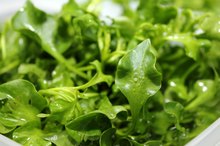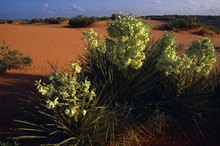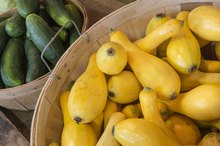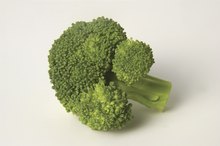The 10 Best Fruits and Vegetables to Plant Anywhere
Life in the big city often includes a small backyard or none at all, but that doesn't mean you have to sacrifice a home veggie garden. Generous sunshine, good soil, irrigation and creativity are the four requirements for a successful city garden. When you take stock of the space available, remember that plants can grow vertically as well as spread out horizontally. Think pallet planting, hanging baskets and planting towers. Even small plots of two or three feet square can sustain a plant or two. Making the best use of every sunny inch requires clever planting techniques, careful crop selection and a little imagination. Here are 10 small-garden edibles that you can try growing this summer!
1. Strawberries
You may dream of tending “strawberry fields forever,” but berries planted in containers taste just as delightful and fit in more readily with small-space gardening. Strawberries mature best with six to 10 hours of direct sun a day, so pick out the sunniest spot in the garden. A small square of flat earth works, but don’t ignore a sunny wall either. You can make strawberries a vertical crop by planting them in a wooden pallet. Select a pallet without pressure-treated wood, and staple landscaping fabric onto the back and bottom. Lean the pallet up against the sunny wall, add a mix of top-quality potting soil and organic fertilizer, and arrange young strawberry plants close together in the spaces. Before you know it, you’ll have a living wall of delightful and healthy berries.
Related: 20 Foods to Always Buy Organic (Even If You’re On a Budget!)
2. Scarlett Runner Beans
Learn More
Sure, beans are low in fat and healthy, but the beauty of the scarlet runner bean may surprise you. It’s a fast-growing vine that climbs to 15 feet, and a stand-out in any garden. The scarlet runner bean vine is perfect for an urban garden because it grows up, not out. It grows happily in a container if you work a few inches of organic compost into the soil before planting. Start the beans indoors in April or sow directly in the pot outside in May. Runner beans require support, but it need not be anything fancy. The vines will climb a trellis, garden canes, strings or netting. Don’t stint on water, especially as the flowers develop; adequate water ensures that the bean pods set. Harvest starts in July and can continue for the rest of the summer.
Related: 11 Nutrients Americans Aren’t Getting Enough Of
3. Shallots
Vegetable or ornamental? Shallots are edibles, a member of the Allium family and termed by cooks “the gourmet onion.” But left in the ground to keep growing, they can produce the lovely round flower clusters typical of the Allium clan. The shallot’s stalk can be snipped into chive, but the real delight of the plant is in the garlic-like bulbs that provide excellent flavor. Plant shallots in a small outdoor bed in full sun, even mixing them in with flowers. Separate bulbs into individual cloves and plant each -- pointy-end up -- in well-drained, organically rich soil. Plant in late fall in USDA hardiness zones 3 through 8 for spring shallots, or in early spring for a summer crop. Provide one inch of water a week and harvest when the stalks brown. Clip off flowers for the best harvest or leave a few to decorate the garden.
Related: 10 Worst Foods for Acid Reflux
4. Meyer Lemon Tree
Companion Planting for Pear Trees
Learn More
If you only invite one potted edible into your garden patio this spring, make it a Meyer lemon tree. The trees have all the wonderful lemon-tree attributes, including lovely leaves and heavenly-scented blossoms, but they are dwarfed -- staying between four and six feet tall -- and fit perfectly into a sunny corner container. The fruit is the same size as a typical lemon, but so sweet that you can even eat the peel. While you can leave your potted Meyers outside all winter in USDA zones 9 through 11, bring them indoors if temperatures in your area dip below 50 degrees. These exceptional lemon trees require full sun, well-drained soil and a wind-protected location to produce. Water them whenever the soil feels dry. Your tree may even produce fruit from the very first year!
Related: 12 Refreshing Spa Water Recipes
5. Romaine Lettuce
Romaine lettuce is a natural for a small garden because it can be tucked beside and between other plants, matures quickly and, like other loose-leaf lettuce, can be harvested over months by removing outer leaves on an “as needed” basis. Many container-grown edibles won’t need their full allotment of space for the first month or so after planting, and romaine wedges in nicely. Or grow it between flowers in the ornamental bed. Romaine matures in less than two months, but you can start picking tender baby leaves for salad as soon as they look big enough, often just weeks after planting. Unlike most garden vegetables, lettuce doesn’t require direct sun to mature. Start setting out romaine plants a month before the last frost of spring. The plants adjust to the space they are given.
Related: Sign Up to Receive the FREE LIVESTRONG.COM Weekly Health and Fitness Newsletter
6. Cherry Tomatoes
If gardeners were asked to vote for the top vegetable to grow in a home garden, odds are that tomatoes would get the nod. Once you taste a red, ripe garden tomato, you’ll never eat the bland supermarket varieties again without regret. Urban gardeners don’t have to miss out. Many varieties of tomato grow well in containers, including full-size Early Girl. But for the most charm and quickest harvest, plant a cherry variety in a hanging basket in a sunny window or patio corner. Cherry Cascade is a good choice. Pick the biggest basket that fits your space and use quality potting soil. Water regularly and add liquid tomato food that is high in potassium. Soon you’ll have a cascade of green foliage and enough red globes flowing over the sides of the basket to keep you in tomatoes for months.
Related: 11 Nutrients Americans Aren’t Getting Enough Of
7. Summer Squash
Mix green and yellow summer squash plants in a small garden bed for a sensual display and a prolific harvest. Summer squash (including zucchini) yield more in less time than winter squash, and the compact varieties are perfect for small backyards and patios. If you want zucchini, try Space Miser for green zucchini or Goldrush for yellow. But don’t forget to try the dozens of types of summer squash available, like pattypan, yellow, tromboncino and zucchetta squash. You’ll need a sunny plot at least two feet square for two plants. Or if you’d rather go with containers, use five-gallon pots. Plant squash in well-drained soil and supply generous irrigation. Pick squash young for the most tender crops.
Related: Cut Calories With These 9 “Pasta Poser” Recipes
8. Kale
Eating kale won’t guarantee you a long, healthy life, but it’s definitely a step in that direction. Kale is another “cut and come back” crop, and you can harvest outer leaves daily or weekly, leaving the inner leaves to grow. Given the dozens of kale cultivars offering different-color leaves, there is no need to stick with one variety, even in a small garden plot or window box. Try Russian kale, scarlet kale, Tuscany or curly green. Kale is a cool-weather veggie, and it needs to ripen before or after the heat of summer. Plant six inches apart in early spring or late in summer for an autumn crop.
Related: 10 Tricks to Save Money and Waste Less of Your Fresh Fruit and Veggies
9. Pea Pods
These flat pea pods are eaten young and tender right off the vine. For gardeners, that means you get more vegetables quicker, since the pods are eaten while immature and without shelling. Also called mangetout, these peas require a support system made of canes, strings, nets or trellises to keep those lovely vines off the ground. A pretty and practical tip for small areas is planting them in long, narrow planters to create a living screen of green. Choose planters at least six inches deep with adequate drain holes and fill them with a combination of organic compost and quality, well-drained potting soil. A layer of large gravel between pot and soil keeps water draining nicely. Plant mangetout seeds in a zigzag pattern, and sow successionally so you can keep those mangetouts coming to the table for months.
Related: 20 Foods to Always Buy Organic (Even If You’re On a Budget!)
10. Herbs
Even if you live in a small studio in downtown Manhattan, you can grow an impressive herb garden as long as you have at least one sunny window. Herbs won’t exactly keep your stomach full, but they add flavor and zing to the foods that do. Pick your favorites and plant them in individual pots with a common theme: different-size tin cans, Mason jars or tea tins work well. For ease of watering, separate thirsty herbs like basil from those that prefer to wait awhile between drinks, like rosemary and thyme.
Related: 11 Nutrients Americans Aren’t Getting Enough Of
Get Planting
Before you rush out to buy seeds or seedlings for your city garden, take the time to consider what you want to grow. Eliminate crops that take up a lot of space, such as Brussels sprouts, large potatoes or asparagus. You’ll get more bang for the buck with space-efficient veggies that come to harvest in weeks, not months. A good rule of thumb: Select vegetables and fruits you love to eat, since it isn’t worth the effort to produce food you’ll pawn off on the neighbors. Product cost counts too. Consider which items of the organic produce you love to eat are most expensive in your area, and then include them on the list you invite into your garden.
Related: 10 Tricks to Save Money and Waste Less of Your Fresh Fruit and Veggies
What Do YOU Think
Have you planted any of these fruits or vegetables before? What are some of your favorites? Any tips or advice for new gardeners? Share your recommendations in the comments section below!
Related Articles
- University of Maryland Extension: Container Vegetable Gardening - Healthy Harvests from Small Spaces
- Gardening Australia Magazine: Off the Wall
- Mother Earth News: All About Growing Strawberries
- Oregon State Extension: Runner Beans Are Beautiful and Edible
- Greenside Up: 14 Vegetables to Grow in a Small Garden
- Sonoma County Master Gardeners: Shallots
- Oregon State University Extension Service: Meyer Lemons Can Be Grown in PNW if Protected in Winter
- Oregon State University Extension Service: How to Grow a Tree on Your Patio
- Gardening Patch: Growing Peas
- Sarah Vantassel









